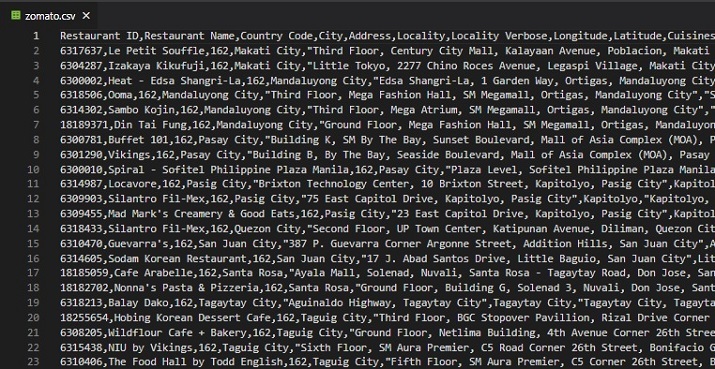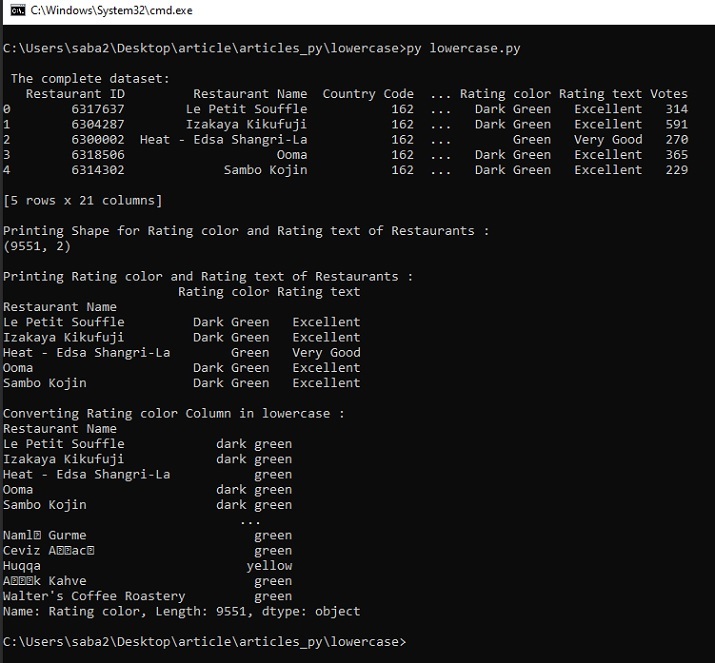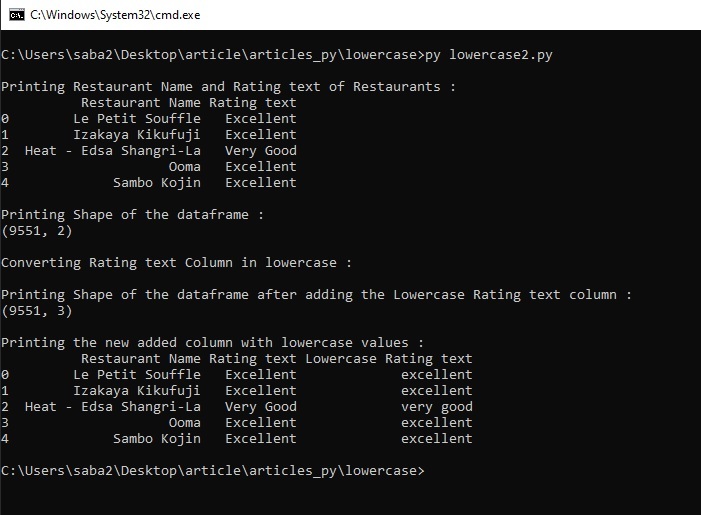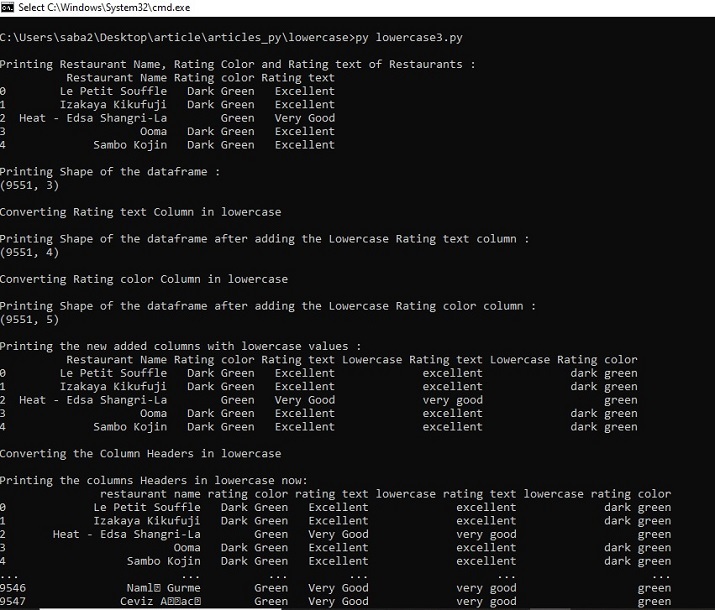如何将 Pandas 数据框中的列名转换为小写?
在本文中,用户将了解如何将 Pandas 数据框中的列名转换为小写。使用三个不同的示例,给出了将数据框列转换为小写的方法。对于这些示例,使用了 Kaggle 上提供的 Zomato 数据集。kaggle 数据集以 CSV(逗号分隔值)格式提供,因此首先下载它,然后使用 pandas 将其转换为数据框。
在第一个示例中,python 程序使用 str.lower() 函数将列值转换为小写。在第二个示例中,map(str.lower) 函数用于将数据框列转换为小写。第三个示例有两个部分。首先,给出使用apply(lambda x: x.lower())函数将列内容更改为小写的方法,然后给出使用map(str.lower, dataframe.columns)将列标题转换为小写的方法。
保存数据分析所需的数据文件/csv文件
对于这些示例,我们将使用Kaggle上可用的数据。登录 Kaggle 并从此链接下载 csv 文件https://www.kaggle.com/datasets/shrutimehta/zomato-restaurants-data
数据集以 CSV 文件形式提供。
使用的 Zomato.CSV 文件

图:此 csv 文件包含 9551 行和 21 列。
示例 1:在数据框列上使用 str.lower() 函数将内容转换为小写
设计步骤和编码
步骤 1 - 首先导入 pandas。现在读取 zomato.csv 文件,因为此处给出的数据集将用于将其加载到数据框中。
步骤 2 - 创建一个数据框 dff1,并使用 pandas 中的 read_table 函数读取 CSV 文件。现在以类似的方式创建另一个数据框 dff2,但使用餐厅名称作为索引列。
步骤 3 - 使用 delimiter=',' 和 zomato.csv 的路径。使用 head 函数从此数据框打印一些行和列。
步骤 4 - 从 dff2 中选择一些需要转换为小写的列。这个新的数据框是 dff3。在 dff3 的其中一列上应用 str.lower()) 并将其转换为小写。
步骤 5 - 运行程序并检查结果。
在 python 文件中写入以下代码
import pandas as pdd
dff1 = pdd.read_table("C:/Users/saba2/Desktop/article/articles_py/tsv/zomato.csv",delimiter=',', encoding='utf-8')
print("\n The complete dataset: ")
print(dff1.head())
dff2 = pdd.read_table('C:/Users/saba2/Desktop/article/articles_py/tsv/zomato.csv', delimiter=',',encoding='utf-8',index_col=1)
#print(" \nThe complete dataset with specified index : ")
#print(dff2.head())
dff3=dff2[["Rating color", "Rating text"]]
print("\nPrinting Shape for Rating color and Rating text of Restaurants : ")
print(dff3.shape)
print("\nPrinting Rating color and Rating text of Restaurants : ")
print(dff3.head())
print("\nConverting Rating color Column in lowercase : ")
print(dff3['Rating color'].str.lower())
输出
在命令窗口中运行 python 文件

图 1:使用 cmd 窗口显示结果。
示例 2:在数据框列上使用 map(str.lower) 函数将内容转换为小写
设计步骤和编码
步骤 1 - 首先导入 pandas。现在读取 zomato.csv 文件,因为此处给出的数据集将用于将其加载到数据框中。
步骤 2 - 制作数据框 dff2 并使用 pandas 中的 read_csv 函数读取 CSV 文件。只需使用 usecols 选择两列"餐厅名称"和"评分文本"。
步骤 3 - 使用 delimiter=',' 和 zomato.csv 的路径。使用 head 函数从此数据框打印一些行和列。
步骤 4 - 将 map(str.lower) 应用于 dff2 的其中一列并将其转换为小写。
步骤 5 - 运行程序并检查结果。
在 python 文件中写入以下代码
import pandas as pdd
dff2 = pdd.read_csv('C:/Users/saba2/Desktop/article/articles_py/tsv/zomato.csv', sep=',',usecols=['Restaurant Name', 'Rating text'])
print("\nPrinting Restaurant Name and Rating text of Restaurants : ")
print(dff2.head())
print("\nPrinting Shape of the dataframe : ")
print(dff2.shape)
print("\nConverting Rating text Column in lowercase : ")
dff2["Lowercase Rating text"]= dff2['Rating text'].map(str.lower)
print("\nPrinting Shape of the dataframe after adding the Lowercase Rating text column : ")
print(dff2.shape)
print("\nPrinting the new added column with lowercase values : ")
print(dff2.head())
输出
在命令窗口中运行 python 文件

图 2:使用 cmd 窗口显示结果。
示例 3:将列标题和内容更改为小写
设计步骤和编码
步骤 1 - 首先导入 pandas。现在读取 zomato.csv 文件,因为此处给出的数据集将用于将其加载到数据框中。
步骤 2 - 创建一个名为 dff2 的数据框并利用 pandas 中的 read_csv 函数读取 CSV 文件。使用 usecols 选择三列,'餐厅名称'、'评分文本' 和 '评分颜色'。
步骤 3 - 使用 delimiter=',' 和 zomato.csv 路径。使用 head 函数从此数据框打印一些行和列。
步骤 4 - 对 dff2 的 '评分文本' 使用 apply(lambda x: x.lower()) 并将其转换为小写。将此小写列添加到数据框中。
步骤 5 - 现在对"评级颜色"列使用步骤 4。
步骤 6 - 对数据框列应用 map(str.lower, dataframe.columns) 函数,将列标题转换为小写。
步骤 7 - 运行程序并检查结果。
在 python 文件中写入以下代码
import pandas as pdd
dff2 = pdd.read_csv('C:/Users/saba2/Desktop/article/articles_py/tsv/zomato.csv', sep=',',usecols=['Restaurant Name', 'Rating color', 'Rating text'])
print("\nPrinting Restaurant Name, Rating Color and Rating text of Restaurants : ")
print(dff2.head())
print("\nPrinting Shape of the dataframe : ")
print(dff2.shape)
print("\nConverting Rating text Column in lowercase")
dff2["Lowercase Rating text"]= dff2['Rating text'].apply(lambda x: x.lower())
print("\nPrinting Shape of the dataframe after adding the Lowercase Rating text column : ")
print(dff2.shape)
print("\nConverting Rating color Column in lowercase")
dff2["Lowercase Rating color"]= dff2['Rating color'].apply(lambda x: x.lower())
print("\nPrinting Shape of the dataframe after adding the Lowercase Rating color column : ")
print(dff2.shape)
print("\nPrinting the new added columns with lowercase values : ")
print(dff2.head())
print("\nConverting the Column Headers in lowercase")
dff2.columns = map(str.lower, dff2.columns)
print("\nPrinting the columns Headers in lowercase now: ")
print(dff2)
输出
在命令窗口中运行 Python 文件。

图 3:使用 cmd 窗口显示结果
结论
在这篇 Python 和 Pandas 文章中,我们使用了三个不同的示例,来演示如何将数据框列的值转换为小写。这三个示例中使用了不同的函数。在第三个示例中,还给出了将列标题更改为小写的方法。


